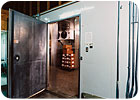
Scroll compressors are being heavily promoted for use in walk-ins.
That is one reason Emerson Climate Technologies has published a white paper called “The Demand for Energy-Saving Incentives for High Efficiency Scroll Compressors in Walk-In Coolers.”
For those who work with commercial refrigeration equipment, the paper explains how scrolls work in the context of walk-ins, especially in terms of efficiencies. And the paper is for key persons with utility companies, consortiums, and state governments to encourage them to consider offering “financial incentives for implementing energy-savings technologies,” such as the use of scrolls.
“Our company and our customers are committed to protecting the environment,” said David Dunbar, president, Emerson Climate Technologies Refrigeration Division. “As a result, we are reaching out to energy companies and regulatory bodies to make sure that our customers are rewarded and recognized for their environmental efforts.”
“The use of high-efficiency refrigeration equipment is extremely important, due to its reduction in on-site electricity usage and by helping organizations like ours to further emphasize the benefits and savings involved in using scroll compressors,” said Rich Hasselman, energy advisor, Focus on Energy, a Wisconsin private-public partnership involved with energy and environmental issues. “This white paper will hopefully educate decision-makers and help encourage widespread adoption of energy-efficient equipment.”
THE SAVINGS
In the broadest sense, the paper said that scroll compressors could reduce energy consumption by up to 20 percent for walk-in coolers used in the food service industry.The paper points out that the dairy industry has already made the move at a more aggressive rate. It has “capitalized on efficiency incentives by replacing conventional reciprocating compressors with scroll compressors in the milk-refrigeration process. Dairy farmers receive tens of thousands of dollars in incentives to upgrade their equipment. Updated dairy-farm equipment reduced annual energy consumption by millions of dollars in participating states.”
The food service sector has not progressed as much, in part due to fewer financial incentives, the paper said.
“While food service owners can take advantage of some energy incentives, these incentives are not yet on par with those offered to the dairy industry.
“To maximize savings for energy producers and consumers, more utilities nationwide must develop policies and programs that reward customers for investing in high-efficiency equipment and processes.”
Such incentives could include rebates, loans, demand-management programs, tax credits, grants, energy audits, and energy-monitoring services.
“More states and utilities should promote incentive-based policies and programs that encourage restaurants and convenience stores to purchase energy-efficient scroll technology for their walk-in coolers,” the report said. “In doing so, states and utilities will be rewarded with stronger consumer relationships and reduced energy-production costs, while restaurant/store owners will benefit from reduced operating expenses.”
THE POTENTIAL
The report contended, “The food service industry has the highest rate of energy consumption per square foot due to its use of specialized, high-energy consuming equipment, including commercial refrigerators, freezers, and walk-ins. Inside restaurant refrigeration accounts for 10-16 percent of energy consumption (of that facility). Inside supermarket refrigeration accounts for 44-62 percent of energy consumption.”Scroll compressors are just one component in technologies that can contribute to energy efficiency. In the case of the dairy industry, “Farmers began replacing conventional reciprocating compressors with more efficient scroll compressors. The farmers collected immediate rebates and other financial incentives from local governments, utilities, and consortiums to install more efficient technology.”
In fact, at the time the report was published earlier this year, incentives specifically offered for using scroll compressors were offered in the states of California, Maine, Minnesota, Vermont, and Wisconsin.
The report said scrolls were now the standard on the dairy side. “The dairy industry adopted (scroll) in the mid-1990s and the technology now comes standard on most new refrigeration systems.”
In an example of efficiency, the study quoted research from Heatcraft Worldwide Refrigeration. “Energy usage for a 1,217-cubic-foot walk-in cooler with a typical run time of 70 percent is 1,216 kilowatt-hour (kWh) per month. A food service owner will pay approximately $1,168 a year in refrigeration expenses using a reciprocating compressor, based on a typical cost of $0.08 per kWh. A high-efficiency scroll compressor costs $956 a year in refrigeration expenses, yielding a $212 (18 percent) annual savings per walk-in cooler.”
The white paper called on those in the industry to campaign to have more incentives available to the food service sector.
“Considering the food service industry’s narrow margins, financial incentives to install high-efficiency compressors cannot be ignored. Using the success the dairy industry has seen with energy-efficient scroll compressors, states and utilities also will benefit by encouraging the installation of high-efficiency compressors in refrigerated walk-ins.
“More states and utilities should promote incentive-based policies and programs that encourage restaurants and convenience stores to purchase scroll technology.”
PublicationDate:07/02/2007


Report Abusive Comment